Walking Exercise (Zi Ran Xing Gong) and Concluding Exercise (Shou Gong)
WALKING EXERCISE (ZI RAN XING GONG)
WALKING
After the preparatory exercise, open eyes and walk ahead as if you were taking a stroll but with special demands of footwork according to type of ailments. Hypertension & heart disease patients of either sex move the left foot forward first, while liver, gallbladder & eyes disease patients move the right foot forward first.
For all others, males move the left foot forward and females move the right foot forward first.
Starting Position
Continue from three rounds of opening & closing — middle dantian
Method — General
1. After completion the 3 rounds of opening and closing —zhong dantian, slowly move the hands to the sides of the hips (200 mm away from hips) at relaxed standing position, then slowly move the right hand (left hand for women) to the front of zhong dantian (about 100 mm apart).
2. Slowly move the body weight to the right foot (left foot for women) and bring the left foot (right foot for women) near the mid-point of the right foot 100-mm apart with toes pointing downward and touch the ground with the toes (FIG. 1-21) and then advance the left foot forward with heels down, toes up without strength and the knees slightly bent (FIG. 1-22) and put the left sole flat on ground (FIG. 1- 23). This is called "touch and start walking (dian jiao qi bu)" . The step should not be too far apart. It is recommended to be half the normal step. The heel down and toes up is to open kidney energy channel, as most of the chronic disease patients are weak in kidney functioning.
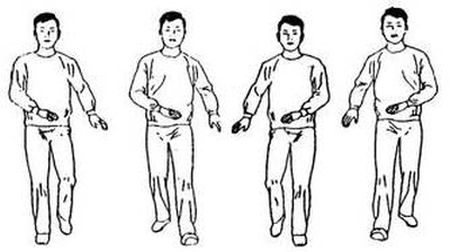
FIG 1-21 FIG 1-22 FIG 1-23 FIG 1-24
3. Advance the right foot forward with heel down, toes up (FIG. 1-24) while simultaneously move the left hand to the front of zhong dantian and the right hand to the side of the right hip then put the sole down flat on ground.
4. Advance the left foot forward with heel down, toes up while simultaneously move the right hand to the front of zhong dantian, left hand to the side of the left hip and then put the left sole down flat on ground. Continue to move forward for 20 minutes, keep the waist, lower back and hips relaxed and both feet in parallel while walking.
5. Advance the rear foot forward parallel to the front foot.
6. Stand at relaxed standing position, do 3 rounds of opening and closing — middle dantian.
7. Repeat Step 1 to 5 as above but with right foot (left foot for women) to advance first.
8. After completion of the walking exercise, stand at relaxed standing position for a while, then perform concluding exercise.
The movement should be rhythmic, unstrained and natural. All joints of the limbs should be relaxed. The principles of roundness, softness and extensiveness must be applied. Armpits should kept exposed throughout the exercise so as to ensure the smooth circulation of inner energy.
ARM SWING
The arm swing with the palms facing the ground is called "release" method, this method must be practiced by cancer patients initially (FIG. 1-25,26,27,28).
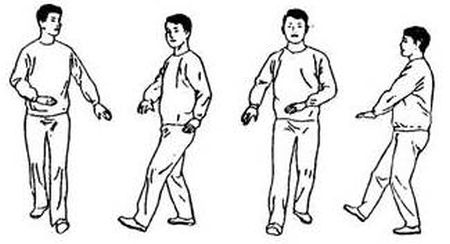
FIG 1-25 FIG 1-26 FIG 1-27 FIG 1-28
The hands move away from Zhong dantian with palms facing to the ground while swing back with palm face to Zhong dantian (FIG. 1-29) is called "balance" method. This method should be practised by the cancer patients after they have recovered for some time.
The hands swinging with palms and fingers facing downward (FIG. 1-30) is called "lowering" method. This method can lower the hyper-indicate ailments such as high blood pressure and blood sugar level.
The hands swinging with the palms facing upward (FIG 1-31) is called "raise" method. This method can improve the health for those with hypo-indicated ailments. All others should swing with the palms facing dantian (FIG. 1-32) which is called "enrich" method. This method should also be practised by hyper or hypo-indicate patients who have recovered from the sickness.
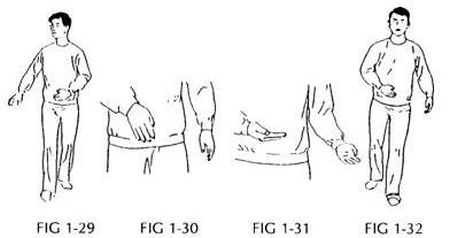
RESPIRATION
1. Normally, moderate strength nasal respiration is used during natural walking. Nasal respiration means inhale and exhale through the nose. There is a slight breezing noise during inhalation and exhalation. All inhalation and exhalation should only be heard by yourself. In nasal respiration for the natural walking exercise, two short inhalation with one breath (i.e xi-xi hu-). The two inhalations must last as long as the one exhalation in order to balance our breath.
2. Nasal respiration must be done in co-ordination with walking and arm swinging. When the heel touches ground for the first step, inhale twice (xi-xi), followed by exhaling once (hu-) when heel touches ground for the second step.
HEAD TURNING
When left foot moves forward first with heel touching on the ground, inhale twice, when the right foot moves forward, turn the head to the right by 45° angle simultaneously, followed by exhaling once when the right heel touches the ground. If you feel that the head turn is too quick and uncomfortable, the head turning can be performed at every 4,6 or 8 walking steps.
IMPORTANT POINTS TO REMEMBER
1. The amount of inhalation and exhalation must be balanced. Some qigong call for inhalation more than exhalation or inhalation less than exhalation. This can cause imbalance of breath and side effects may happen.
2. Nasal Respiration is very seldom mentioned in the ancient Qigong literature. However, practical experience in China over the past 20 years have shown that this nasal respiration in co-ordination with walking and arm movennent exercise created by Master Guo Lin is particularly suitable for treatment of chronic diseases and also definitely can prolong the life of cancer patients and alleviate their symptoms.
3. During practice, both hands swing away and return to dantian. Do not "throw" the hands in order to prevent inner energy loss from hands.
4. When inhaling twice, the diaphragm must feel some vibration. Do not force breathing with nose.
5. When doing the first step forward, males and females with heart and heart related disease must forward with the left foot first. Liver, gallbladder and eyes patients must forward first step with right foot and toes landing on the ground. For all others, males should forward first step with left foot while females forward first step with right foot.
ADDITIONAL INFORMATION
TONGUE
During walking, the tip of the tongue must touch the edge of the hard palate jointed to the upper teeth without force. This bridge and improve the circulation of inner energy from the governing channel to the conception channel.
EYES
During practice, both eyes should look straight ahead and follow where the head turns to and at horizontal position to prevent the head from tilting. When looking at something, you should allow yourself to be in a state that you seem to "look at them but at the same time see nothing" as well "see things without paying attention". In this way, your mind can stay relaxed and tranquil with no distracting thoughts.
SALIVA
During exercise, saliva may increase and accumulate in the mouth. Do not spit it out. Stop walking and swallow slowly in three gulps at relaxed standing position, imagining that the saliva passing through the throat and stomach and finally reaching zhong dantian. Then do a three rounds of opening and closing-zhong dantian and continue walking.
WALKING SPEED
Natural walking should be performed naturally. The speed of walking and respiration is according to the body and health condition of each individual. The aim is to achieve rhythmic and unstrained breathing without gasping for breath. In general, walking at a speed of 20-30 steps per min is suitable while some may walk with a speed of 100 steps per min and achieve good results.
CONCLUDING EXERCISE - (SHOU GONG)
1. After walking for approximately 40 minutes, return to the relaxed standing position with eyes closed.
2. Perform three rounds of opening and closing —zhong dantian
3. Perform three cycles of breathing-zhong dantian
4. Perform relaxed standing for 2 minutes or more by mental counting the numbers.
The session takes approximately 40 minutes. Very sick and weak patients can reduce the time to suit, however they must increase the time as they progress with their health accordingly. In general, walking for 20 minutes then stop in relaxed standing position for a while and then perform 3 rounds of opening and closing-middle dantian. Then change foot and walk again for 20 minutes followed by concluding exercise.
In between each session, take a break by sitting down for 10-15 mins to allow the inner energy to be distributed to the whole body.
Adopted from The Art of Qigong, produced by Persatuan Guolin Qigong Malaysia



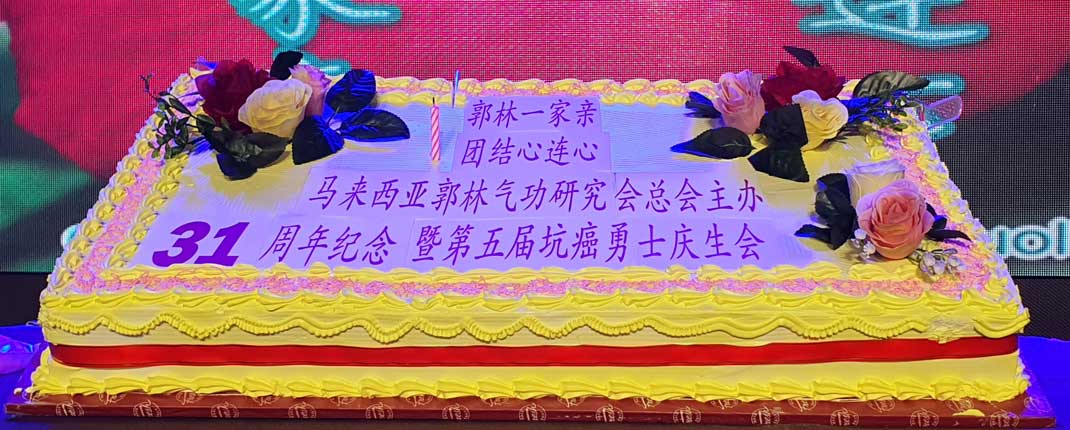
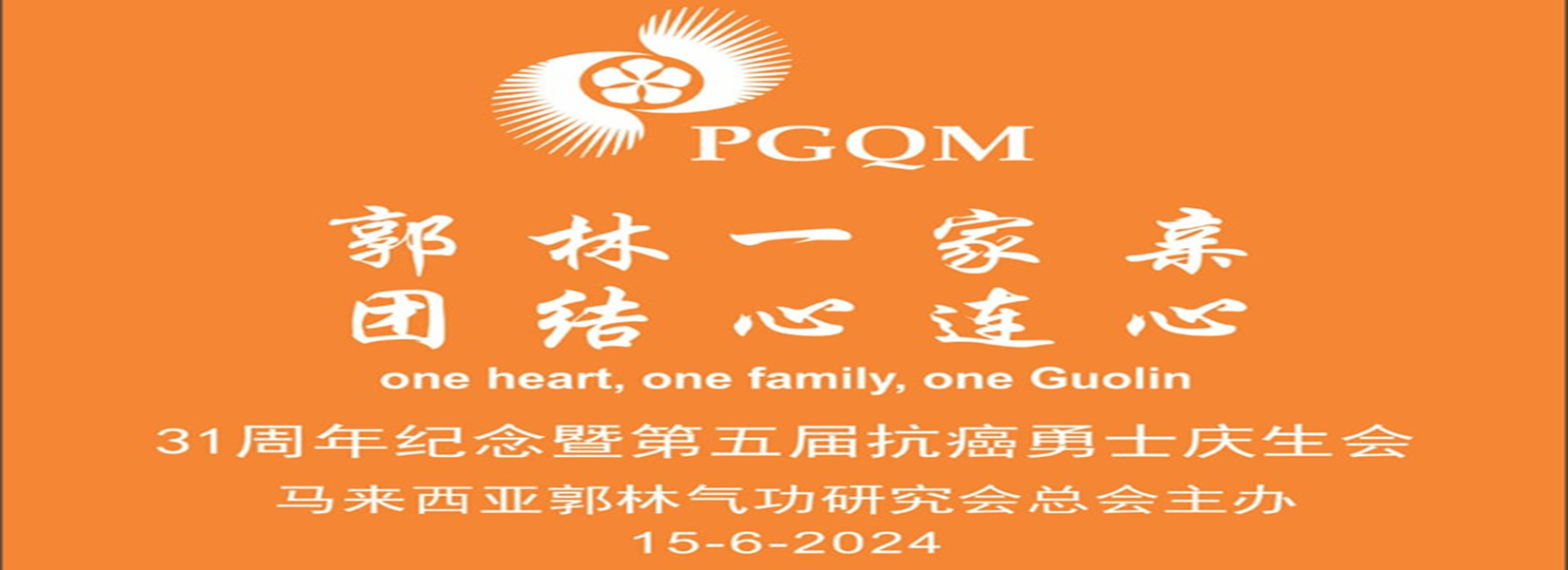




 Whatsapp
Whatsapp